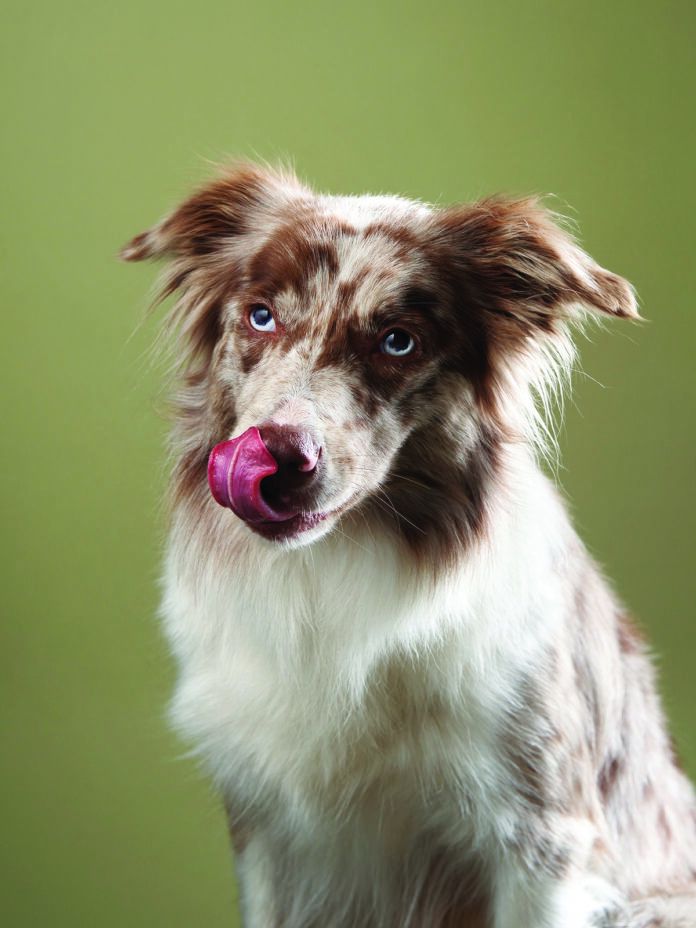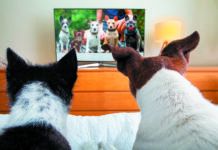Sure, you know that if your dog tucks her tail between her legs, she’s feeling terribly afraid, or at least extremely uncomfortable. It’s a clear signal that you should remove her from whatever situation is unnerving her. But what about the more subtle signs of canine stress? Can you identify them so that you can calm your dog when she’s nervous? Here are six of them.
6. Licking her lips. Lip licking as a sign of stress crosses the species barrier. People do it, too. You might see a dog licking her lips in the waiting room of a veterinarian’s office, which is a signal that you should try to calm her down. Lip licking could also be a sign of canine supplication or polite entreaty. When dogs are puppies, they lick their mother’s lips so she will regurgitate some food for them. They will then eat those regurgitated morsels.
7. Licking your lips. If your dog senses consternation, anxiety, or anger in you, she might lick you to help you stay calm — and thereby keep her own equilibrium from being upended. Why would she do that? She probably learned from you at some point — perhaps as a puppy — that licking you makes you laugh and puts you in a good mood. And the lesson stuck: “When I lick my person’s lips, they seem delighted. When they are delighted, I am treated well. I don’t feel frightened.” Voilà, the dog’s anxiety is allayed.
8. Yawning. Sure, a dog may yawn when she’s tired, but more often yawning indicates stress. It’s a way of trying to cope with the stress by engaging in a neutral behavior. People do it, too, albeit maybe not with yawning. Let’s say you’re feeling stressed because an elevator is stopping on every floor and you’re late for a meeting. What you want is for the elevator to keep moving. But to deal with the stress of the floor-by-floor delay, you might take out your phone and check for texts even though you just did that a minute ago. Or perhaps you’ll rummage through your briefcase. It’s a way of dealing with the inner conflict — wanting not to be late but having to endure the endless elevator ride.
It’s the same for a dog who yawns in response to a frustrating or otherwise stressful situation: “I want to cross to that side of the street to check out the dog that’s walking past, but attached to the leash, I have no choice but to stay on this side.”
9. Panting. Dogs pant when they’re overheated because that helps regulate their body temperature; unlike us, they don’t have sweat glands on most of their skin to help them cool down. But they also pant when they’re nervous. That’s why, for instance, you might see a dog pant doing a thunderstorm if she has thunderstorm phobia. Stay calm and talk soothingly. She needs your reassurance when she’s panting from anxiety, not your annoyance.
10. Goosebumps. Goosebumps on a dog don’t look like goosebumps on people — little prickles of skin sticking up when the person does something like watch a scary scene in a horror flick. It’s more like the hair on the dog’s back stands straight up. It’s the same reflex that causes the reaction in both species — tiny little muscles flex from fear, shock, or anxiety in response to a surge in hormones. We’ve heard a number of people reprimanding their dogs to put their fur back down. They can’t, just like you can’t “decide” to stop having goosebumps. They go away when you calm down. To that end, help your dog return to a state of calmness rather than berating her about a bodily reflex over which she has no control.
11. Averting your gaze. Dogs are not big on direct stares. They find them forward and aggressive. They do become accustomed to our looking directly at them — and also become habituated to looking right back at us. But if you see your dog making sure not to look right at you, chances are she’s nervous. You might think she’s being disrespectful and disinclined to obey, but it’s the opposite. She’s saying, “I’m not looking for any trouble. I mean no harm.” The thing to do in that situation is reassure your pet rather than start talking forcefully to try to make her look at you.





